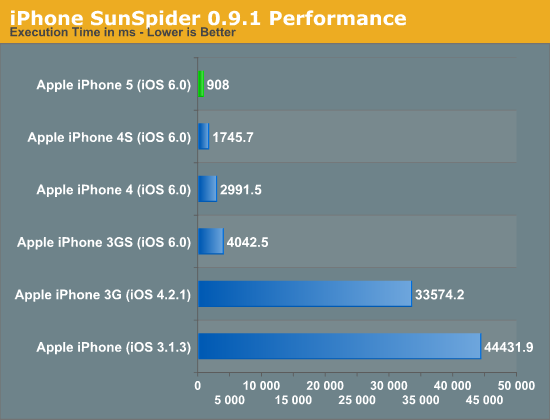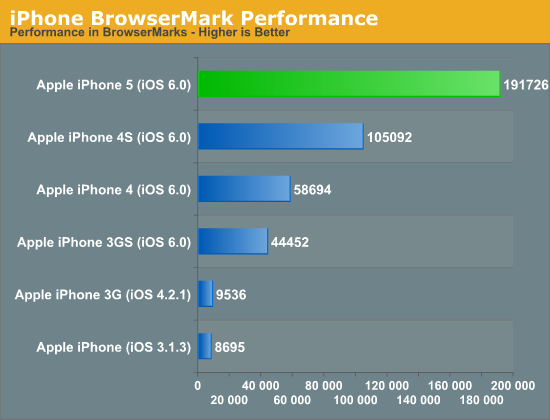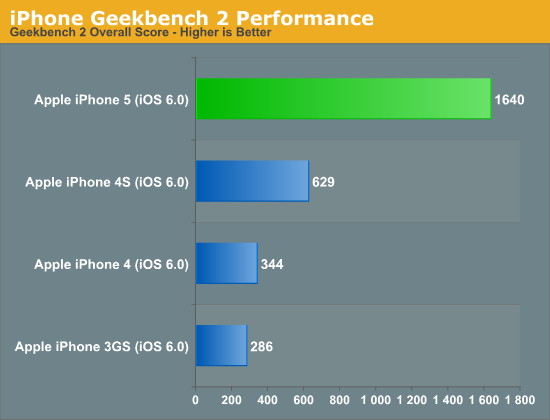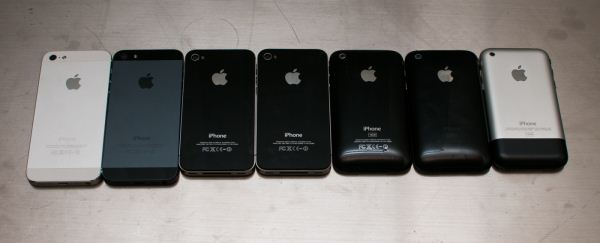The iPhone 5 Review
by Anand Lal Shimpi, Brian Klug & Vivek Gowri on October 16, 2012 11:33 AM EST- Posted in
- Smartphones
- Apple
- Mobile
- iPhone 5
Six Generations of iPhones: Performance Compared
Section by Anand Shimpi
Cross platform smartphone benchmarks are interesting, but they do come with their own sets of issues. Before we get to that analysis however, let's look at how the iPhone's performance has improved over the past six generations. Luckily Brian has a set of all of the iPhones so he was able to run a few tests on all of the devices, each running the latest supported OS.
We'll start with SunSpider 0.9.1, our trusty javascript performance test:

The transition from iPhone to iPhone 3G shows you just how much additional performance you can squeeze out of simply a software change. There's likely even more that could be squeezed out of that ARM11 platform, unfortunately newer versions of Safari/iOS aren't supported on the iPhone 3G so we're left with a runtime that's around 37x the length of a single run on the iPhone 5.
The rest of the devices support and run iOS 6, so we're at least on a level software playing field. The performance boost from one generation to the next is quite significant still. Going by this chart alone, the best balance of minimal upgrades and maximum perceived improvement would be from the original iPhone to the 3GS then again from the 3GS to the 5.

The BrowserMark results tell a similar story. The jump from the ARM11 based iPhone/iPhone 3G to the 3GS running iOS 6 is huge. Both the 4S and 5 offer doublings in performance, albeit for different reasons. The 4S delivered a doubling thanks to a doubling of core count and a move to the Cortex A9, while the iPhone 5 doubled performance through a much higher clock speed and microarchitectural improvements.
Finally we have Geekbench 2, which only runs on the iOS 6 supported devices so we say goodbye to the original iPhone and iPhone 3G:

None of the jumps looks as dramatic as the move to the iPhone 5, but we already know why. The Swift CPU architecture does a great job improving memory performance, which shows up quite nicely in a lot of the Geekbench 2 subtests.
On the PC side we often talk about 20% performance improvements from one generation to the next being significant. It's clear that the mobile SoC space is still operating along a hyper Moore's Law curve. The rate of progress will eventually slow down, but I don't see that happening for at least another couple generations. The move to ARM's Cortex A15 will be met with another increase in performance (and a similarly large set of power challenges), and whatever comes next will push smartphones into a completely new category of performance.












276 Comments
View All Comments
avner - Tuesday, October 16, 2012 - link
Are you sure the HTC One S has a removable battery? Last time I checked, it was internally sealed because of the phone's unibody design....tipoo - Tuesday, October 16, 2012 - link
I'll be curious to know if the paint holds up well after a few months, but I have no idea how long you get to keep this for testing. The easily scratchable back is already rustling some jimmies on the internet, but I don't know if that's something that's overstated again or if it is a real problem.The softness of aluminum they can't get around, I know that much (the front of the iPod Classic and any Macbook Pro are quite dent prone), but the paint chipping is a separate issue.
dagamer34 - Tuesday, October 16, 2012 - link
Not paint, anodization. You should watch the video on page 1.Alucard291 - Tuesday, October 16, 2012 - link
Yeah and in this instance its holding even worse than paint. So your point is?doobydoo - Friday, October 19, 2012 - link
Depends how thick the paint is, and what the paint consists of. And his point was to improve the accuracy of the original post, not necessarily to disagree with its conclusion.tipoo - Saturday, October 20, 2012 - link
Does a name make it more durable? :PI'd still like a follow up in a few months if that is possible.
extide - Thursday, December 6, 2012 - link
It ISN'T paint. That's the point. Anodized aluminum is actually quite a bit harder than regular aluminum so the anodization process makes it more durable. All they really need to do is make the anodization layer a bit thicker.KPOM - Tuesday, October 16, 2012 - link
I was wondering what was taking so long. Now I know. Thanks for all the great information.dyc4ha - Tuesday, October 16, 2012 - link
Hi,I can't help but wonder why the price aspects are omitted in the review. As per the famous AT saying: "there are no bad products, only bad prices". So what about the iPhone 5 value proposition for $650+tax? Contract pricing? i.e. is it worth signing on for a contract?
I'm asking because, well it is a widely accepted 'fact' that Apple overprice its products, but I would love to hear perhaps justifications from reputable sources such as yourselves. Most of my friends already jumped the ship from 4/4s to a GS3. I paid for a number of apps over the years, not sure if I want to repurchase all of them if I end up switching.
Cheers
darwinosx - Tuesday, October 16, 2012 - link
iPhone 5 starts at $599 not $650. Go check retail on a Galaxy S3.it is not widely accepted that Apple "overprices" Compare iPad and iPhone prices to current Android. Prices are same and sometimes cheaper.
Compare Mac prices to equivalent build level PC's.
People sho say Apple overprices don't know Apples or their competitors prices. They just want to whine about Apple.